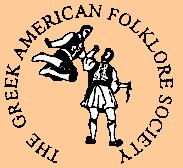Costumes: Thessaly - The Karagounian Costume
/There has not yet been a definitive interpretation of the name "Karagounis". N.A. Veis writes it derives from kara("black" in Turkish) and gouna ("coat") which, however, is not a part of their costume, while N. Eleftherides writes that it derives from karayiounan, a compound word from the Turkish kara and the Greek name Ionas, which in Persian becomes yiounan from Iaoun (Iaon, Ion) and is used generally to mean Greek.
The bridal costume worn in the Thessalian plain is still used in our days in a modified and simplified version. It has a chemise, the linomaniko poukamiso, edged with a thick black fringe on the hem and sleeves. The diplos sayias consists of two cotton dresses. The outer dress, which is usually of indigo-blue color, has many folds and an added border sewn upon the hem, with embroidered patterns matching those of the short waistcoat, the yileki. The front of the bust is covered by a dickey of cotton material. The costume includes an apron of felt, and an apron made of silk. The kavadomanika, which are ornamental arm-bends, are worn over the sleeves. The head is dressed with false plaits and a cotton or silk kerchief. The costume is accompanied by a great many ornaments. The winter version of the costume has a heavy overcoat made of black wool.
Benaki Museum
Ioanna Papantoniou



